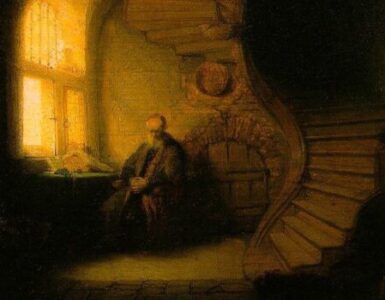There is something about the way women are
introduced in the Bible that sets Mary apart from the general pattern.
Often, in the Old Testament, major women are
introduced by way of their male relatives, even if it is the women who are the
more significant characters.
For example, here’s how we meet Hannah:
There was a certain man from Ramathaim, a Zuphite from the hill country of Ephraim. His name was Elkanah, the son of Jeroham, son of Elihu, son of Tohu, son of Zuph, an Ephraimite.
He had two wives, one named Hannah, the other Peninnah; Peninnah had children, but Hannah had no children (1 Samuel 1:1-2).
Hannah is the main character in the story that
follows, not Elkanah, but he is presented first. The narrative beings with,
“There was a certain man…” as opposed to what we would expect given that Hannah
is the focus, “There was a certain woman. …”
Likewise, Ruth and Naomi:
Once back in the time of the judges there was a famine in the land; so a man from Bethlehem of Judah left home with his wife and two sons to reside on the plateau of Moab.
The man was named Elimelech, his wife Naomi, and his sons Mahlon and Chilion; they were Ephrathites from Bethlehem of Judah. Some time after their arrival on the plateau of Moab, Elimelech, the husband of Naomi, died, and she was left with her two sons.
They married Moabite women, one named Orpah, the other Ruth (Ruth 1:1-4).
And again, the initial account of Esther, mirrors 1
Samuel:
There was in the royal precinct of Susa a certain Jew named Mordecai, son of Jair, son of Shimei, son of Kish, a Benjaminite, who had been exiled from Jerusalem with the captives taken with Jeconiah, king of Judah, whom Nebuchadnezzar, king of Babylon, had deported.
He became foster father to his cousin Hadassah, that is, Esther, when she lost both father and mother (Esther 2:5-7).
The narrative structures of these stories may seem like they reflect the norms of a patriarchal society. Of course, it’s important to note that ancient Israel did not always follow what we might expect from ancient cultures. One thinks of the judge Deborah and the Jewish assassin Judith, who beheads the Assyrian general Holofernes. So we should be wary of focusing too much on cultural factors for understanding these stories. There is a deeply biblical basis for the pattern noted above: Adam did, after all, precede Eve in the creation account.
The important point is how different Mary’s
introduction is from so many of the women who preceded her:
In the sixth month, the angel Gabriel was sent from God to a town of Galilee called Nazareth, to a virgin betrothed to a man named Joseph, of the house of David, and the virgin’s name was Mary.
And coming to her, he said, “Hail, favored one! The Lord is with you” (Luke 1:26-28).
Notice how the order is reversed from what we might
expect in the Old Testament. Following the typical pattern we would more likely
see something like: ‘There was a man name Joseph, who lived in a town of
Galilee called Nazareth. He was betrothed to a virgin named Mary.’
However, here, Mary steps out from under the shadows, with Joseph taking second place in the sequence. This cannot be an accident. The Church teaches us that as the New Eve, Mary reverses what happened in Eden. As Adam came first, then Eve, it is therefore fitting that in the story of the New Adam and the New Eve, that the New Eve be mentioned first.
There is a further twist: under the new order,
Joseph, her husband, isn’t even her Adam. Instead, it’s her son, Jesus.
Thus, in the New Testament, Mary’s importance is not merely derived from her relationship to Joseph. To the contrary, Joseph’s importance can seem to be derived from his status as the earthly husband of the Mother of God, and later as the earthly father of Jesus.
But take another closer look at Luke 1. Mary is
still not mentioned first in the story: In
the sixth month, the angel Gabriel was sent from God. … Angels do not really have gender since they don’t reproduce, yet the names they are
given are male names—Gabriel, Michael, Raphael. Moreover, in the Book of
Daniel, Gabriel is described as ‘one who looked like a man’ (Daniel
8:15-16).
So, in a way, Mary still does follow the Old
Testament pattern of having a male, or an apparent male in her case, get first
mention. Read in context of the Old Testament, it suggests a heavenly
relationship for Mary. The first impression the biblical writer wants to give
of Mary is as a receiver of heavenly messages. It is her orientation towards
heaven that is foremost.
This conclusion is reinforced by the fact that
Gabriel venerates her, addressing her with the royal greeting: ‘Hail.’ She is a
resident of Nazareth but she is also of his world, which is why he declares
that she is ‘full of grace.’
Unlike the Biblical women before her, Mary is singularly graced. Although it is from her that Jesus takes His humanity, Mary is very much a heavenly figure from the beginning. Indeed, in introducing her by way of Gabriel, Luke invites us to see her from the perspective of heaven. May that stir an ever greater devotion to her among us still on this earth.
✠
Photo by Maria Oswalt on Unsplash












